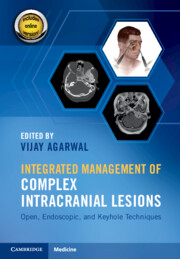Book contents
- Integrated Management of Complex Intracranial Lesions
- Integrated Management of Complex Intracranial Lesions
- Copyright page
- Dedication
- Contents
- Contributors
- Foreword
- Section I Endoscopic Endonasal (EN) Combined Approaches
- Section II Open Combined Approaches
- Chapter 6 Combined Transcranial Approach for Tumor Resection and Anterior Circulation Vascular Bypass
- Chapter 7 Hybrid/Combined Strategies for Vestibular Schwannomas
- Chapter 8 Transchoroidal, Subchoroidal, and Combined Approaches to the Third Ventricle
- Chapter 9 Combined Orbitofrontal Craniotomy and Direct Orbital Decompression
- Chapter 10 Transbasal and Transfacial Approach for Paranasal and Anterior Cranial Fossa Tumors
- Chapter 11 Combined Middle Fossa Craniotomy and Mastoidectomy for Cerebrospinal Fluid Leak Repair and Encephalocele Resection
- Chapter 12 Transcochlear and Extended/Combined Transcochlear Approaches for Complex Tumors of the Skull Base and Posterior Cranial Fossa
- Chapter 13 Combined Retrosigmoid and Orbitozygomatic Approach
- Chapter 14 Combined Retrosigmoid and Limited Anterior Petrosectomy (“Reverse Petrosectomy”)
- Chapter 15 Combined Suboccipital Craniotomy and Neck Dissection
- Chapter 16 Combined Petrosal Approach
- Chapter 17 Combined Keyhole Paramedian Supracerebellar-Transtentorial Approach
- Chapter 18 Combined Multi-portal “Pull-Through” Keyhole Craniotomy
- Chapter 19 Combined Keyhole Craniotomies for Multifocal or Multiple Lesions
- Chapter 20 Combined Microsurgical and Endovascular Treatment of Cerebrovascular and Skull Base Pathology
- Chapter 21 Combined Transsylvian-Subtemporal Approach to Anterior Circulation and Basilar Apex Aneurysms
- Index
- References
Chapter 21 - Combined Transsylvian-Subtemporal Approach to Anterior Circulation and Basilar Apex Aneurysms
from Section II - Open Combined Approaches
Published online by Cambridge University Press: 05 October 2021
- Integrated Management of Complex Intracranial Lesions
- Integrated Management of Complex Intracranial Lesions
- Copyright page
- Dedication
- Contents
- Contributors
- Foreword
- Section I Endoscopic Endonasal (EN) Combined Approaches
- Section II Open Combined Approaches
- Chapter 6 Combined Transcranial Approach for Tumor Resection and Anterior Circulation Vascular Bypass
- Chapter 7 Hybrid/Combined Strategies for Vestibular Schwannomas
- Chapter 8 Transchoroidal, Subchoroidal, and Combined Approaches to the Third Ventricle
- Chapter 9 Combined Orbitofrontal Craniotomy and Direct Orbital Decompression
- Chapter 10 Transbasal and Transfacial Approach for Paranasal and Anterior Cranial Fossa Tumors
- Chapter 11 Combined Middle Fossa Craniotomy and Mastoidectomy for Cerebrospinal Fluid Leak Repair and Encephalocele Resection
- Chapter 12 Transcochlear and Extended/Combined Transcochlear Approaches for Complex Tumors of the Skull Base and Posterior Cranial Fossa
- Chapter 13 Combined Retrosigmoid and Orbitozygomatic Approach
- Chapter 14 Combined Retrosigmoid and Limited Anterior Petrosectomy (“Reverse Petrosectomy”)
- Chapter 15 Combined Suboccipital Craniotomy and Neck Dissection
- Chapter 16 Combined Petrosal Approach
- Chapter 17 Combined Keyhole Paramedian Supracerebellar-Transtentorial Approach
- Chapter 18 Combined Multi-portal “Pull-Through” Keyhole Craniotomy
- Chapter 19 Combined Keyhole Craniotomies for Multifocal or Multiple Lesions
- Chapter 20 Combined Microsurgical and Endovascular Treatment of Cerebrovascular and Skull Base Pathology
- Chapter 21 Combined Transsylvian-Subtemporal Approach to Anterior Circulation and Basilar Apex Aneurysms
- Index
- References
Summary
Traditionally, two approaches have been utilized to access the rostral basilar artery (BA) for clipping aneurysms. These are: 1) the subtemporal approach pioneered by Canadian neurosurgeon Charles George Drake and 2) the transsylvian or pterional approach popularized by Turkish neurosurgeon Mahmut Gazi Yasargil. Both of these approaches have assets and liabilities, and both have modifications to expand the surgical field of view. Some rostral BA aneurysms and some patients with aneurysms of both the anterior and posterior circulation requiring clip ligation may benefit from a combined transsylvian and subtemporal (half-and-half) exposure. In this chapter, we describe our version of that approach, which provides access to both anterior and posterior circulation aneurysms. We detail neuroanesthesia considerations, patient positioning, bone drilling, subarachnoid dissection, and clip placement. Also included is an illustrative case.
- Type
- Chapter
- Information
- Integrated Management of Complex Intracranial LesionsOpen, Endoscopic, and Keyhole Techniques, pp. 214 - 222Publisher: Cambridge University PressPrint publication year: 2021



